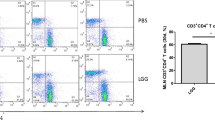Abstract.
In premature infants with necrotizing enterocolitis (NEC) the gastrointestinal mucosal barrier is immature, but little is known about the immune response of immature bowel. The aim of this study was to evaluate the intestinal mucosal immune response in experimental NEC. In general anaesthesia, NEC was induced in six newborn piglets by injection of bovine casein into terminal ileum. Six controls received an equal amount of saline. Four hours later, samples were taken from the macroscopically most affected part of the treated loop and from the macroscopically healthy untreated intestine. Monoclonal antibodies to porcine CD1, CD2, CD4, CD8, CD45 and IgM were used for immunohistochemical staining. Casein-treated bowel showed typical macro- and microscopic findings of NEC. No changes were found in the saline-treated bowel. In both groups the bowel outside the treatment sector was normal. In casein-treated animals, treated samples showed significant decrease in density of CD4+ cells when compared with saline-treated controls. Similar trend was found in CD2+ and CD8+ cells but without statistical significance. Macroscopically healthy proximal untreated samples showed significant decrease in densities of CD2+, CD4+ and CD8+ lymphocytes in casein-treated group when compared with control samples. In casein-treated animals the density of CD45+ cells in the non-injected bowel was also decreased, but this did not reach statistical significance. Densities of CD1+ and IgM+ cells did not differ between casein-treated and saline-treated groups. A significant T-cell decrease was found in the present NEC model. Surprisingly, this was most prominent in the macroscopically healthy bowel outside the casein injection segment. The reason for T-cell decrease remains unclear, but bovine casein is known to contain peptide fractions that can modulate immune function. These findings may have implications in the design of neonatal milk formulas.


Similar content being viewed by others
References
Kosloske AM (1994) Epidemiology of necrotizing enterocolitis. Acta Paediatr (Suppl) 396:2–7
Beeby PJ, Jeffery H (1992) Risk factors for necrotising enterocolitis: the influence of gestational age. Arch Dis Child 67:432–435
Holman RC, Stoll BJ, Clarke MJ, Glass RI (1997) The epidemiology of necrotizing enterocolitis infant mortality in the United States. Am J Public Health 87:2026–2031
Stoll BJ (1994) Epidemiology of necrotizing enterocolitis. Clin Perinatol 21:205–218
Neu J (1996) Necrotizing enterocolitis: the search for a unifying pathogenic theory leading to prevention. Pediatr Clin North Am 43:409–432
Deitch EA (1994) Role of bacterial translocation in necrotizing enterocolitis. Acta Paediatr (Suppl) 396:33–36
Israel EJ (1994) Neonatal necrotizing enterocolitis, a disease of the immature intestinal mucosal barrier. Acta Paediatr (Suppl) 396:27–32
Mannick E, Udall JN Jr (1996) Neonatal gastrointestinal mucosal immunity. Clin Perinatol 23:287–304
Udall JN Jr (1990) Gastrointestinal host defense and necrotizing enterocolitis. J Pediatr 117:S33–S43
Clark DA, Thompson JE, Weiner LB, McMillan JA, Schneider AJ, Rokahr JE (1985) Necrotizing enterocolitis: intraluminal biochemistry in human neonates and a rabbit model. Pediatr Res 19:919–921
Lorenzo M di, Bass J, Krantis A (1995) An intraluminal model of necrotizing enterocolitis in the developing neonatal piglet. J Pediatr Surg 30:1138–1142
Koivusalo A, Kauppinen H, Anttila A, Heikkila P, Rintala R, Lindahl H (2000) Rectosigmoid pHi monitoring during experimental necrotizing enterocolitis. J Pediatr Surg 35:1462–1467
Denham S, Shimizu M, Bianchi ATJ, Zwart RJ, Carr MM, Parkhouse RME (1994) Monoclonal antibodies recognising differentiation antigens on porcine B cells. Vet Immunol Immunopathol 43:259–267
Pescovitz MD, Aasted B, Canals A, Dominguez J, Vizcaino JS, Pospisil R, Sinkora J, Salmon H, Valpotic I, Davis WC, Arn S, Sachs DH, Lunney JK, Zuckerman F, Weiland E, Saalmuller A (1994) Analysis of monoclonal antibodies reactive with the porcine CD2 antigen. Vet Immunol Immunopathol 43:229–232
Pescovitz MD, Aasted B, Canals A, Dominguez J, Vizcaino JS, Pospisil R, Trebichavsky I, Salmon H, Valpotic I, Davis WC, Arn S, Sachs DH, Lunney JK, Zuckerman F, Weiland E, Saalmuller A (1994) Analysis of monoclonal antibodies reactive with the porcine CD4 antigen. Vet Immunol Immunopathol 43:233–236
Saalmuller A, Aasted B, Canals A, Dominguez J, Goldman T, Lunney JK, Maurer S, Pescovitz MD, Pospisil R, Salmon H, Trebichavsky I, Valpotic I, Vizcaino JS, Zuckermann F (1994) Analyses of mAb reactive with porcine CD8. Vet Immunol Immunopathol 43:249–254
Zuckermann FA, Binns RM, Husmann R, Yang H, Carr MM, Kim YB, Davis WC, Misfeldt M, Lunney JK (1994) Analyses of monoclonal antibodies reactive with porcine CD44 and CD45. Vet Immunol Immunopathol 43:293–305
Crissinger KD (1995) Animal models of necrotizing enterocolitis. J Pediatr Gastroenterol Nutr 20:17–22
Nadler EP, Dickinson E, Knisely A, Zhang X-R, Boyle P, Beer-Stolz D, Watkins SC, Ford HR (2000) Expression of inducible nitric oxide synthase and interleukin-12 in experimental necrotizing enterocolitis. J Surg Res 92:71–77
Nathakumar NN, Fusunyan RD, Sanderson I, Walker WA (2000) Inflammation in the developing human intestine: a possible pathophysiologic contribution to necrotizing enterocolitis. PNAS 97:6043–6048
Halpern MD, Holubec H, Dominguez JA, Williams CS, Meza YG, McWilliam DL, Payne CM, McCuskey RS, Besselsen DG, Dvorak B (2002) Up-regulation of IL-18 and IL-12 in the ileum of neonatal rats with necrotizing enterocolitis. Pediatr Res 51:733–739
Shah NP (2000) Effects of milk-derived bioactives: an overview. Br J Nutr 84 (Suppl 1):S3–S10
Cross ML, Gill HS (2000) Immunomodulatory properties of milk. Br J Nutr 84 (Suppl 1):S81–S89
Acknowledgements
This work was supported by The Finnish Pediatric Research Foundation.
Author information
Authors and Affiliations
Corresponding author
Rights and permissions
About this article
Cite this article
Anttila, A., Kauppinen, H., Koivusalo, A. et al. T-cell-mediated mucosal immunity is attenuated in experimental necrotizing enterocolitis. Ped Surgery Int 19, 326–330 (2003). https://doi.org/10.1007/s00383-003-1004-7
Accepted:
Published:
Issue Date:
DOI: https://doi.org/10.1007/s00383-003-1004-7




